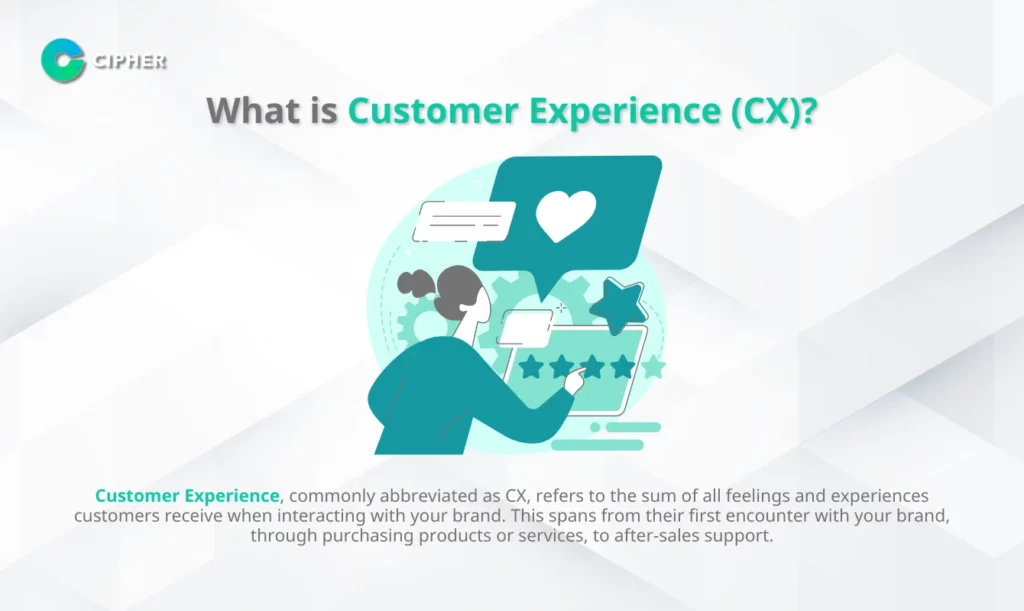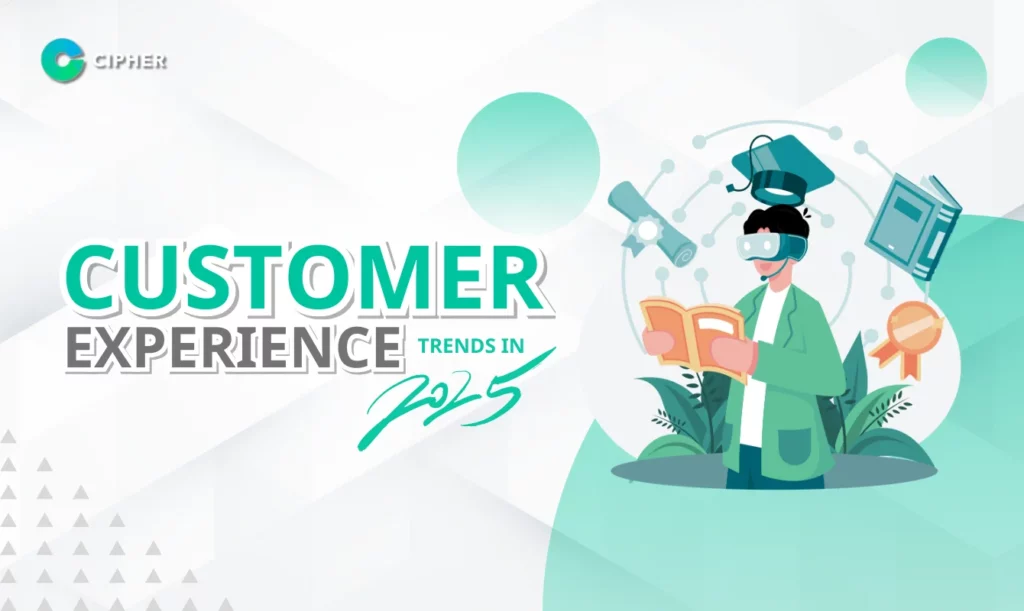Table of Contents
What is Customer Experience (CX)?

Customer Experience, commonly abbreviated as CX, refers to the sum of all feelings and experiences customers receive when interacting with your brand. This spans from their first encounter with your brand, through purchasing products or services, to after-sales support. CX isn’t limited to a single touchpoint but encompasses the overall impression from all interactions customers have with your brand throughout the entire process. These feelings and perceptions create lasting impressions and influence future purchase decisions. Effective CRM systems play a crucial role in tracking and enhancing these customer interactions.
CX differs from Customer Service in several ways. While Customer Service focuses on serving customers at specific moments, solving immediate problems, and answering customer questions, Customer Experience covers all touchpoints customers have with your brand from beginning to end. The experience of using products or services is just one component of CX.
Additionally, CX differs from User Experience (UX), which emphasizes experiences during product usage, such as aesthetics and ease of use. CX presents a broader picture, including experiences before and after usage. Many organizations use Enterprise Content Management Systems to help deliver consistent experiences across these touchpoints.
Why Customer Experience Matters for Businesses
In today’s highly competitive business landscape, creating excellent customer experiences has become a crucial strategy for business survival and growth. Studies show that 89% of businesses compete primarily on Customer Experience. According to Zendesk research, companies should prioritize investing in customer experience to stay competitive. Here’s why CX is vital for businesses and has become the heart of Customer Experience Marketing:
- The new competitive battlefield for businesses – As products and services become increasingly similar, customers choose brands based on the quality of experiences they receive. Approximately 80% of organizations anticipate that they will compete mainly on Customer Experience trends that meet customer needs.
- Builds loyalty and retains customers – Loyal customers return to make repeat purchases, spend more, and recommend your brand to others. Notably, 86% of consumers will stop using a brand after just two negative experiences. Focusing on creating distinctive customer experiences is therefore essential.
- Increases revenue and profits – Companies that prioritize Customer Experience grow faster and are more profitable. About 41% of customer-centric companies experienced revenue growth of at least 10% in the past year.
- Builds brand reputation and encourages word-of-mouth – When customers have positive experiences, they often share these with others through positive reviews and ratings, increasing brand visibility and awareness. This is the power of Customer Experience Marketing that doesn’t require significant advertising investment. Effective social media marketing strategies can amplify these positive customer experiences.
- Customers are willing to pay more for better experiences – Surveys indicate that 48% of consumers are willing to pay more for quality Customer Service that meets their needs, and 46% will pay more when brands can deliver personalized experiences.
Customer Experience Trends to Watch in 2025

1. Implementation of AI Copilots and Automation
AI Copilots or intelligent assistants powered by AI are trending among companies looking to enhance customer interactions. According to surveys:
- 93% of CX trendsetters believe that copiloting systems are an excellent way to help both customers and staff become familiar with AI
- 90% of CX trendsetters believe that 80% of problems will be resolvable without human intervention within the next few years
- The use of Shadow AI (using external AI not approved by companies) has increased by 250% in 2025
2. Data-Rich Digital Twins
Businesses will use more customer data to create Digital Twins, virtual replicas of customers that reflect their behaviors and preferences. These Digital Twins will help businesses:
- Experiment with new products and services in risk-free virtual environments
- Predict customer reactions
- Adjust strategies for optimal results
For example, the city of Incheon in South Korea has implemented Digital Twins to create a Smart City to tackle flooding issues. Similarly, businesses can use this concept to simulate customer behavior and accurately predict needs.
3. Prescriptive Hyper-Personalization
Prescriptive hyper-personalization will take customization to the next level by not only predicting customer needs but also encouraging customers to take actions aligned with their values. This approach helps build deep loyalty by connecting experiences with personal values.
For example, e-commerce platforms can use predictive analytics with machine learning to recommend products matching customer preferences at the right time, such as sending special promotions during periods when customers are likely to be interested in purchasing those items.
4. Predictive Customer Experience Management (PCEM)
PCEM will use advanced predictive analytics to anticipate customer needs and improve customer journeys in real-time. These systems can:
- Predict future customer behaviors and preferences
- Help companies deliver experiences tailored appropriately to customers
- Proactively address potential issues
For example, hotels can use PCEM to anticipate guest needs, such as booking lead times or amenities they’re likely to use, and send discount offers or recommend additional services at appropriate times.
5. Voice AI and Screenless Interfaces
Natural Voice AI is becoming increasingly popular:
- 51% of consumers have interacted with advanced Voice AI
- 60% are looking forward to companies implementing this technology more widely
Meanwhile, Zero-UI Interfaces are changing customer interactions without relying on screens or physical controls. Customers can use voice commands, gestures, or biometric signals to communicate with brands more conveniently and naturally.
6. Immersive Technologies
By 2025, businesses will adopt immersive technologies like Virtual Reality (VR) and Augmented Reality (AR) to create more engaging and interactive customer experiences. For example, fashion brands can use VR to let customers virtually try on clothes, helping them better understand products and potentially reducing return rates.
Additionally, there’s a trend toward Hyper-Reality customer experiences that blend AR and VR to create realistic experiences and blur the boundaries between digital and physical worlds.
7. Biometric-Driven Personalization
Personalizing customer experiences with biometric data will use information from the body, such as facial recognition or fingerprints, to create experiences tailored to individual customers. Businesses can:
- Customize interfaces to suit users
- Recommend products matching needs
- Adapt store environments to individual requirements
For example, in the banking industry, facial recognition verification helps customers perform transactions conveniently without visiting the bank.
Using AI Technology to Enhance Customer Experience
1. AI and Customer Trust
Consumer trust in AI Agents depends on their ability to create interactions, friendliness, and human-like qualities. Future AI development will not only focus on quick responses and accurate answers but also on creating good interactions that are friendly and similar to human conversations.
Success story: Siemens’ finance department, Europe’s largest manufacturer, succeeded in building trust and nearly doubling efficiency with AI Agents that not only respond immediately to customer requests, such as sending invoices, but can also predict consumer needs.
2. Personal AI Assistants and the Future of Customer Service
The popularity of Personal AI Assistants is encouraging companies to prepare for a future where these assistants will lead in work. Implementing these technologies is becoming a key component of comprehensive marketing mix strategies that balance technological innovation with traditional marketing elements. Different age groups have confidence in using AI Assistants in different ways:
- Baby Boomers (60+ years) are more confident using AI for product tracking than other groups
- Gen X (45-59 years) are confident using AI for scheduling appointments
- Millennials or Gen Y (30-44 years) are confident using AI for receiving information and personalized services
- Gen Z (18-29 years) are confident using AI for financial transactions
By 2027, almost all CX trendsetters (87%) plan to design experiences where AI Assistants play a role throughout the purchasing journey.
3. Chatbots That Benefit Customers
Modern chatbots have developed significantly, becoming smarter and better at understanding how to answer questions quickly and accurately. Some systems can even seamlessly switch between working with human admins. Professional social media management services often integrate these advanced chatbots to enhance customer interactions. The benefits of modern chatbots include:
- Reducing the workload of human admins
- Reducing part-time admin hiring
- Reducing the need to train new employees
- Responding to customers 24 hours a day
Using chatbots and social media chatbots that can interact in real-time will increase customer satisfaction and efficiently reduce customer service costs.
4. Generative AI for Customizing Customer Experiences
Generative AI is a type of artificial intelligence that uses algorithms to learn from various datasets to create new outcomes similar to but different from the original data. This technology has high potential for Customer Experience applications:
- Creating diverse marketing campaigns customizable to customer needs
- Creating user manuals specific to gender, age, or interests
- Enhancing customer service efficiency
- Connecting behavioral data and trends to make accurate decisions
Data Analysis Trends to Improve CX
1. Sentiment Analysis
AI-driven sentiment analysis tools help businesses understand customer emotions and adjust responses accordingly. These tools analyze data such as tone of voice, word choice, and even typing speed to assess customers’ emotional states.
Sentiment analysis helps businesses track and respond to customers’ emotional states at every step of their journey. For example, if a customer shows dissatisfaction during an interaction with a chatbot, the system can detect negative emotions and transfer the conversation to a human employee for immediate personal support.
2. Quantum Computing in Customer Experience Analysis
Quantum Computing is changing how businesses analyze big data. This technology enables faster and more accurate analysis of large and complex data, helping businesses:
- Better understand customers and predict behaviors
- Improve real-time personalized customer experiences to meet specific needs
- Analyze complex insights to find service improvement opportunities
For example, if a customer likes fashion products, the system can recommend items they might like during times they’re likely to buy and can adjust product recommendations in real-time as additional data is collected.
3. Customer Journey Mapping
Businesses are using data analysis to present maps and record every customer interaction throughout their journey. Understanding the customer’s path from first interaction to post-purchase engagement is key to improving customer experience, helping businesses:
- Create connected and personalized experiences
- Ensure different teams are aligned
- Identify pain points and make improvements
For example, if data reveals that customers frequently abandon shopping carts at the payment step, businesses can investigate the reasons behind this behavior and make necessary improvements to reduce payment complications.
4. Synthetic Customers and Behavior Prediction
The trend of creating Synthetic Customers is gaining popularity, resulting from the development of Generative AI, data privacy, and digital twin concepts. This technology helps companies:
- Simulate customer behavior
- Predict where problems will occur in the customer journey
- Predict the best paths to optimal outcomes
In 2025, creating synthetic customers will be more effective with real-time data including transaction information and social media sentiments, making it an extremely useful tool for improving customer service.
Customer Experience Examples and Ways to Create Good Experiences
Successful Customer Experience examples today often come from brands that prioritize every customer touchpoint, such as Apple, which emphasizes experiences from packaging design, stores, applications, and after-sales service, or Starbucks, which creates a coffee shop atmosphere that’s more than just a place to sell drinks but a meeting place.
Creating good customer experiences requires establishing approaches that cover all interactions customers have with your business. Here are recommended steps to get started:
1. Laying the Foundation
- Define vision and goals: Determine what kind of customer experience you want to create and set clear goals, such as being known for excellent customer service, personalized experiences, or cutting-edge technology.
- Understand your customers: Conduct market research, analyze customer data, and gather feedback from surveys, interviews, and social media monitoring to understand needs, preferences, and problems customers encounter.
- Create customer journey maps: Identify every point where customers interact with your brand, from first awareness to post-purchase contact.
- Define important metrics and KPIs: Choose indicators aligned with business goals, such as customer satisfaction, customer retention rate, Net Promoter Score (NPS), and Customer Lifetime Value.
2. Building Infrastructure
- People in the organization are key drivers: Provide tools, training, and authority to deliver excellent customer experiences. Create a customer-centric culture.
- Prioritize communication and collaboration: Ensure everyone shares common Customer Experience goals through regular meetings, shared dashboards, and integrated communication tools.
- Develop customer feedback systems: Create channels for customers to easily provide suggestions and ensure you listen and respond to these opinions.
- Customize user experience (UX): Improve websites, applications, and other digital connection points to make them easy to use, attractive, and impressive.
3. Delivery and Improvement
- Customize interactions to meet customer needs: Use data and insights to anticipate individual customers’ needs and preferences.
- Ensure speed and problem-solving: Answer customer questions quickly and efficiently, with clear processes for handling complaints and resolving issues.
- Reward loyal customers: Show appreciation to loyal customers with special offers, reward programs, and personal recognition.
- Monitor and improve continuously: Regularly check CX metrics, conduct A/B testing, and follow industry best practices.
Cipher Services to Enhance Customer Experience
Cipher is a full-service Digital Marketing agency ready to help your business enhance customer experiences through various services:
1. Analysis of Customer Behavior and Needs
2. Design and Development of Omnichannel Systems
3. Development of Chatbots and AI Systems for Customer Service
4. Creating Content That Reaches and Addresses Customer Needs
5. Measuring and Continuously Improving Efficiency
Conclusion: Addressing Future Customer Experience Trends
Customer Experience (CX) is becoming an important competitive arena for businesses in 2025 as customers have higher expectations and demand experiences superior to competitors. As the marketing landscape continues to evolve, prominent Customer Experience trends in 2025 include using AI Copilots and automation, Digital Twins, Hyper-Personalization, Predictive Customer Experience Management (PCEM), Voice AI, immersive technologies, and biometric-driven personalization.
Future Customer Experience Marketing will focus on using AI and modern technologies to create more personalized and meaningful experiences for customers. Businesses that prioritize CX development will have a competitive advantage and can build sustainable relationships with customers.
If you want to enhance your business’s customer experience, Cipher is ready to serve you with a team of experts and cutting-edge technology. Contact us today to start creating excellent customer experiences that exceed expectations.





